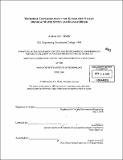Microbial contamination in the Kathmandu Valley drinking water supply and Bagmati River
Author(s)
Wolfe, Andrea N. C. (Andrea Nancy Cornell), 1977-
DownloadFull printable version (10.10Mb)
Alternative title
Microbial contamination of the Kathmandu Valley drinking water supply and Bagmati River
Other Contributors
Massachusetts Institute of Technology. Dept. of Civil and Environmental Engineering.
Advisor
Susan Murcott.
Terms of use
Metadata
Show full item recordAbstract
The purpose of this investigation was to determine and describe the microbial drinking water quality problems in the Kathmandu Valley. Microbial testing for total coliform, E.coli, and H2S producing bacteria was performed in January 2000 on drinking water sources, treatment plants, distribution points, and consumption points. Existing studies of the water quality problems in Kathmandu were also analyzed and comparisons of both data sets characterized seasonal, treatment plant, and city sector variations in the drinking water quality. Results showed that 50% of well sources were microbially contaminated and surface water sources were contaminated in 100% of samples. No samples from drinking water treatment plant outflow were microbially contaminated; however almost 80% of samples collected at distribution points had microbial contamination and 60% were contaminated with E.coli. Drinking water quality varied little throughout the city but had significant seasonal variation. Microbial contamination in the Bagmati River was also studied and extremely high levels of microbial pollution were found. Pollution concentrations in the river are increasing over time as the population of the Valley grows rapidly. Wastewater treatment is virtually non-existent and most of the wastewater generated in the City flows untreated into the river. This causes increased pollution concentrations as the Bagmati flows downstream from the sparsely populated headwaters through the heavily urbanized Kathmandu City. Despite the high microbial pollution levels, many people use the river for washing, scavenging, and religious purposes. These activities, as well as contaminated drinking water, threaten the health of the population. Recommendations for drinking and surface water quality improvements can be divided into three areas: regulatory, policy, and technical. Laws and regulations are needed that specify those individuals and agencies who are responsible for water quality and monitoring, set water quality standards, and assign penalties to polluters. Drinking water policy must focus on fully funding programs and educating the public. Technical recommendations include separating drinking water and wastewater pipelines to eliminate leakage between the two and community or household-scale systems for both drinking water and wastewater treatment.
Description
Thesis (M.Eng.)--Massachusetts Institute of Technology, Dept. of Civil and Environmental Engineering, 2000. Includes bibliographical references (leaves 70-71).
Date issued
2000Department
Massachusetts Institute of Technology. Department of Civil and Environmental EngineeringPublisher
Massachusetts Institute of Technology
Keywords
Civil and Environmental Engineering.